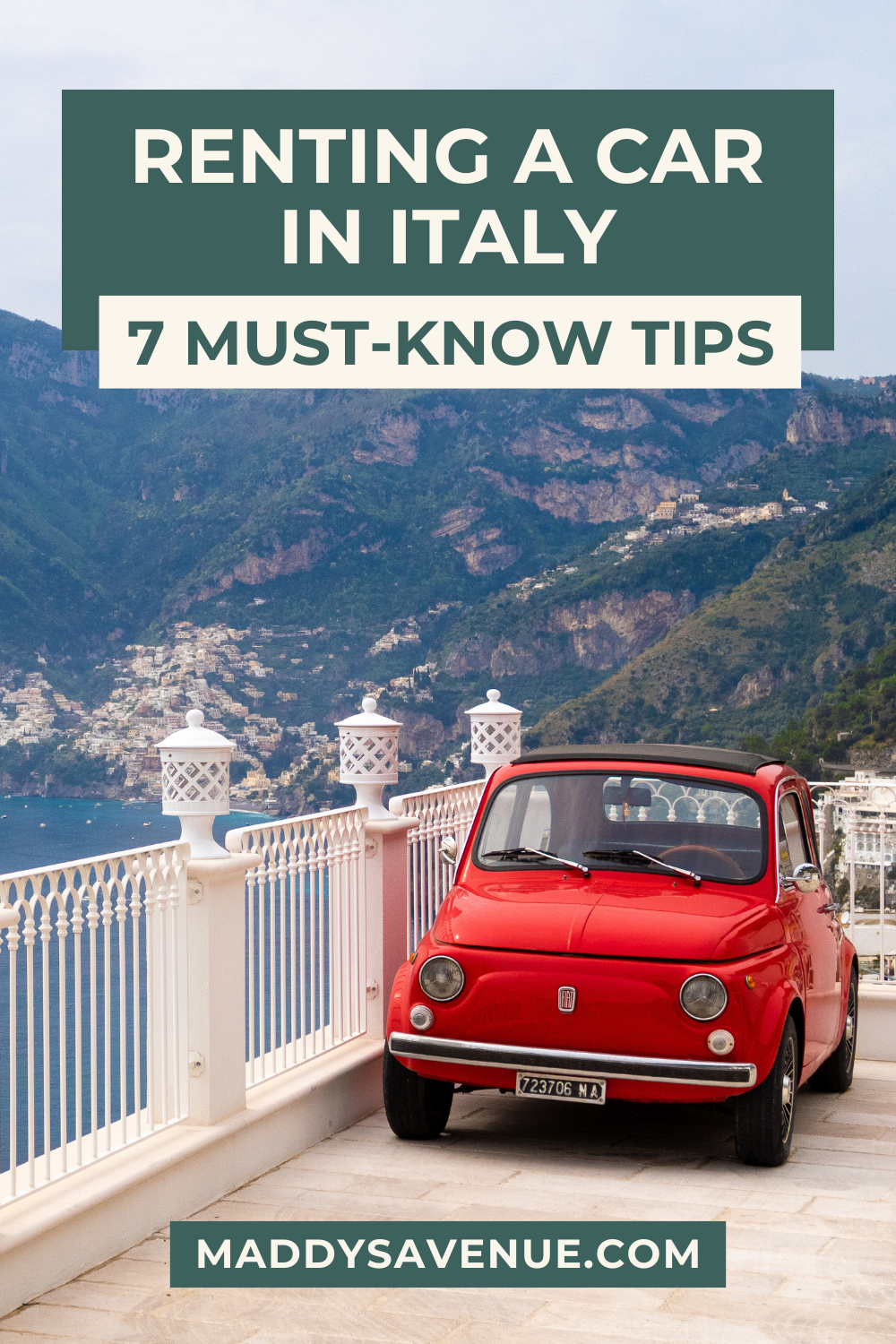Driving in Italy? 7 Things to Know Before Renting a Car
Disclosure: This post may contain affiliate links; more info here.
Planning on driving in Italy? I’ve planned my fair share of successful Italian road trips and, I have to say, I love exploring Italy by car.
With a rental car, you can dive deep into Italian culture, access off-beat vineyards, hiking trails, beaches, and hot springs, and visit lesser-known towns that aren’t connected by public transportation. In epic road-tripping regions like Puglia, Tuscany, Umbria, and the Dolomites, you’ll be so happy you decided to rent a car.

Yet, driving in Italy isn’t always all rolling hills, olive groves, and sunflower fields… It can also be stressful and confusing – and, not to mention, the source of plenty of expensive tickets if you’re not careful!
So, before you rent a car in Italy, there are some things you need to know. In this guide, you’ll find seven must-know tips to help you have a seamless Italian self-driving adventure. Buon viaggio!
7 Things You Need to Know Before Driving in Italy

1. You need an international driver’s license.
In Italy, you are legally required to carry an international driver’s license/permit. Rental car companies usually don’t ask for it when you pick up your car, but you’ll receive a large fine if you get pulled over.
In the Dolomites, we were pulled over at a checkpoint and fined €282 (in cash, on the spot!) just for not having an international driver’s license. Super annoying!
In the US, you can get an international driving permit from the American Automobile Association (AAA) for $20.

2. You must be aware of “ZTL” zones.
In Italy’s historic city and town centers, driving is typically restricted by ZTL (Zona a Traffico Limitato or Limited Traffic Zone) signs. Usually, this means that only residents are allowed to drive within the zone – either 100% of the time, or during certain hours when the ZTL is active (attiva). That’s because tourist areas are mainly pedestrian-only.
If you enter an active ZTL, you will likely receive a large fine in the mail when you get home. There are ticketing cameras everywhere! If the ZTL sign says it’s inactive (non-attiva), then you can usually enter.
But, to avoid stress, confusion, and tickets, I simply recommend not driving into the Centro Storico (historic center) of any city or town at any time.
I have seen videos online of travelers arriving home to dozens of tickets in the mail (totaling thousands of euros!) for driving in ZTLs, so be very careful!

3. You should plan where to park in advance.
If you’re driving to a city or town, I highly recommend having a parking plan before hitting the road. Between ZTLs, traffic, and one-way streets, having a solid plan will save you a lot of stress!
In your Google Maps app, I recommend searching for parcheggio (parking lot) or parcheggio gratuito (free parking lot), then “saving” the lot’s location for your arrival.
If you find available street parking, note the color of the parking lines:
- White lines = free
- Blue lines = paid (so you’ll need to find the parking meter nearby to pay)
- Yellow lines = reserved for those with permits (i.e. residents or disabled people)
Also, when booking hotels, try to choose places that include free overnight parking. It’ll make your life so much easier!

4. There are speed cameras everywhere.
Compared to the US, there are speed traps (speed cameras) everywhere in Italy.
The decent thing is that warning signs are always clearly posted ahead of the cameras. As you drive, look out for signs that say controllo elettronico della velocità – usually alongside a symbol of a policeman.
Navigation apps like Google Maps and Waze often indicate where speed cameras are located along your route, too.

5. Make sure you have the right insurance.
I’m no legal expert, but before I drive out of the rental car lot, I always make sure that I have third-party insurance, first-party insurance (“collision damage waiver”), and travel insurance.
- My understanding is that basic third-party insurance – covering others’ vehicles and injuries – is included with all Italian rental cars. However, it’s up to you to confirm this with your rental car company.
- I get my first-party insurance – covering my rental car for collision damage and theft – by paying for the rental with one of my travel credit cards.
- For personal medical emergencies, I have an affordable travel insurance policy which I pay for on a monthly subscription. In my opinion, you should never travel internationally without travel insurance.
Do your due diligence and make sure you’re properly insured before you rent a car in Italy.
6. Driving in Italy can be (very) stressful.
This may be the most important point. Can you keep your cool under pressure? If not, driving in Italy may not be for you…
Personally, I don’t like driving in Italy; I find it too stressful. But, lucky for me, my husband is a great driver and is always cool as a cucumber. Plus, he loves driving.
Between local drivers’ unpredictable maneuvers and extreme tailgating, narrow country lanes, bumpy dirt roads, old cobblestone streets, scary cliffside roads, limited parking, and ZTL zones, driving in Italy can be pretty challenging. Be ready for it!
Side note: Please, don’t even think about driving along the Amalfi Coast. This is the worst idea ever – for so many reasons!

7. Know where to find the best deals.
I recommend using this website to find the best deals on rental cars in Italy. It aggregates many of the rental car companies’ rates so you can compare prices and perks. Usually, this site offers free cancellation too, – just in case.

Best Italian Regions for Road Tripping
Italy’s public transportation system is pretty great, especially if you’re planning to city-hop between main tourist hubs like Rome, Florence, Verona, Venice, Milan, and Bologna. Plus, thanks to pedestrian-friendly streets, trains, trams, buses, and taxis, you’ll never need a car in a big city.
Self-driving really shines when you’re planning to visit smaller towns and explore the countryside, islands, or mountainous areas; these places are harder to reach without a car.

If you’re looking for some Italian road trip inspiration, consider these areas:
- Tuscany: You can visit towns and small cities like San Gimignano, Volterra, Siena, Lucca, Cortona, Montepulciano, Montalcino, and Monteriggioni, while stopping by countless family-run wineries, agriturismos, hot springs, and more.
- Umbria: Countless organic vineyards like this one and ancient towns like Spello, Assisi, Spoleto, and Gubbio await.
- Puglia: Seaside towns like Polignano a Mare, Gallipoli, and Otranto, vineyards like this one, cheese factories like this one, beautiful baroque cities like Lecce, and whitewashed hilltop villages like Ostuni and Locorotondo are perfect destinations in Puglia for road-tripping.
- The Dolomites (Italian Alps): This may be the world’s most beautiful road-tripping destination! You need a car to easily access different lakes, hiking trailheads, scenic restaurants, and small towns.
- Ischia: Ischia is probably my favorite place in Italy. To properly explore this island, you need a rental car!
- Sicily: Outside of the cities like Palermo and Catania, public transportation across Sicily is pretty terrible. If you want to get off the beaten path (trust me, you do!), you should rent a car. From spending one day in Taormina, lapping up the beaches in Cefalù, hiking Mt. Etna, and driving through the Agrigento Valley, you’re in for an epic trip.
SAVE THIS POST ON PINTEREST!



